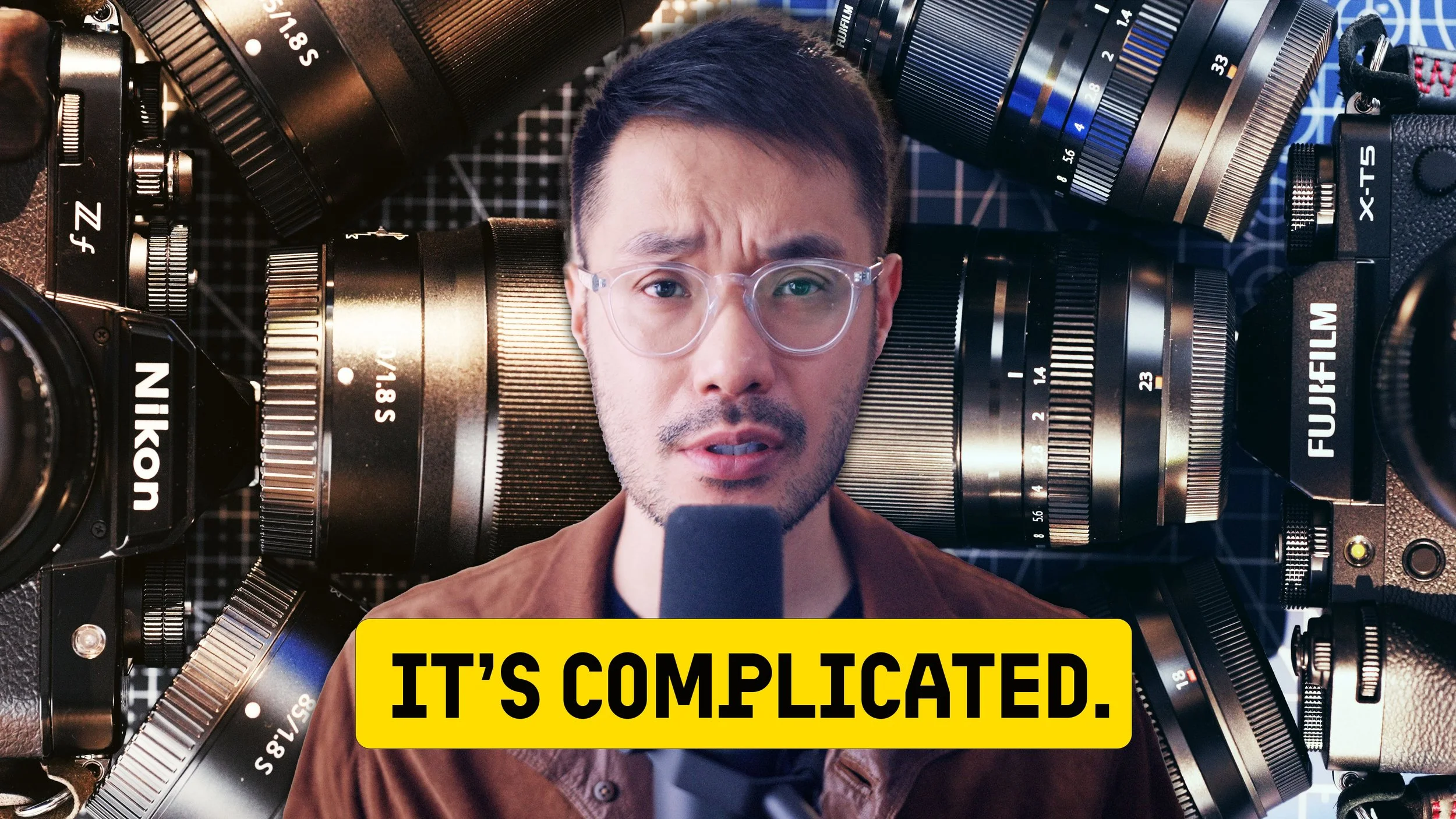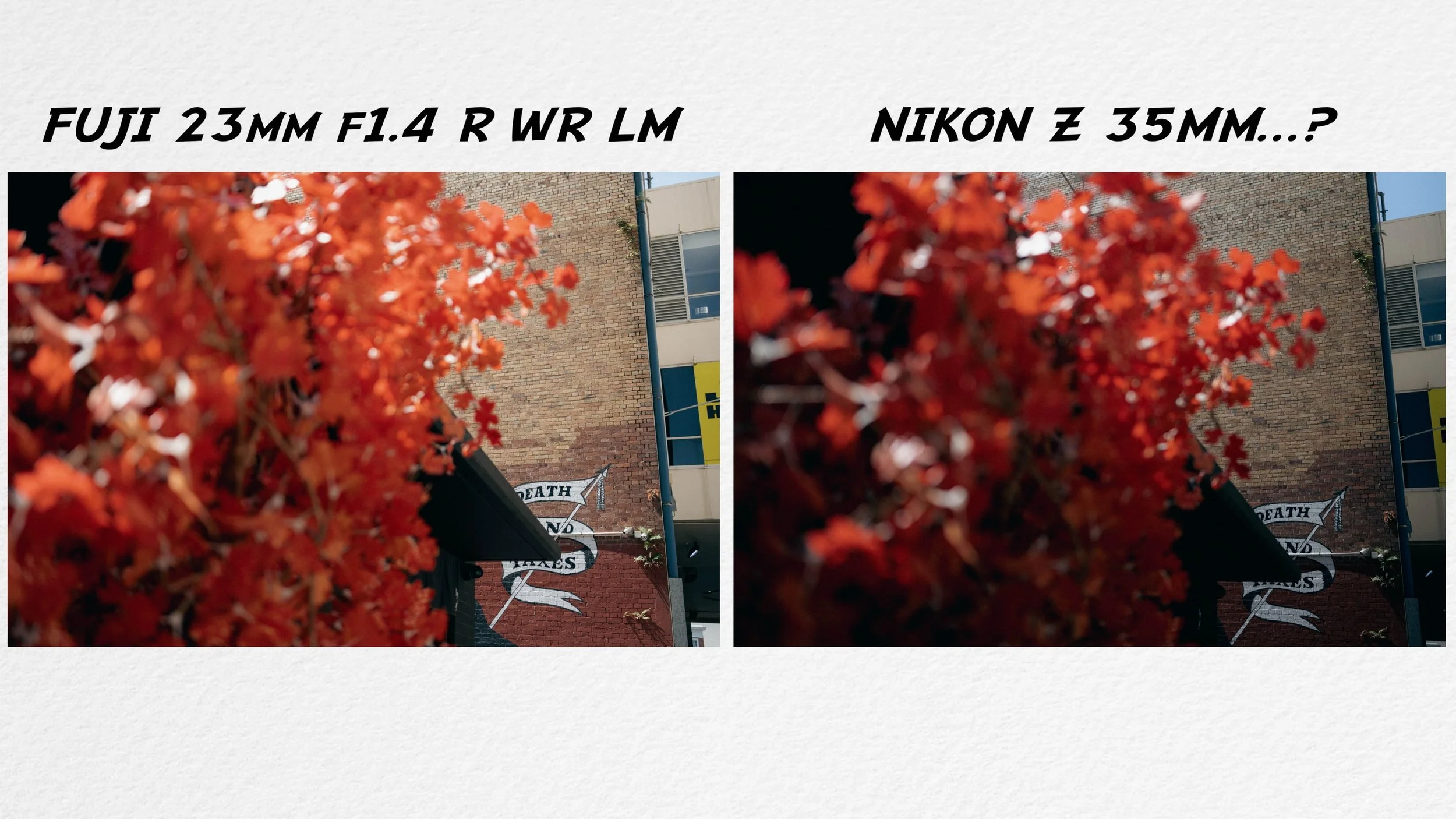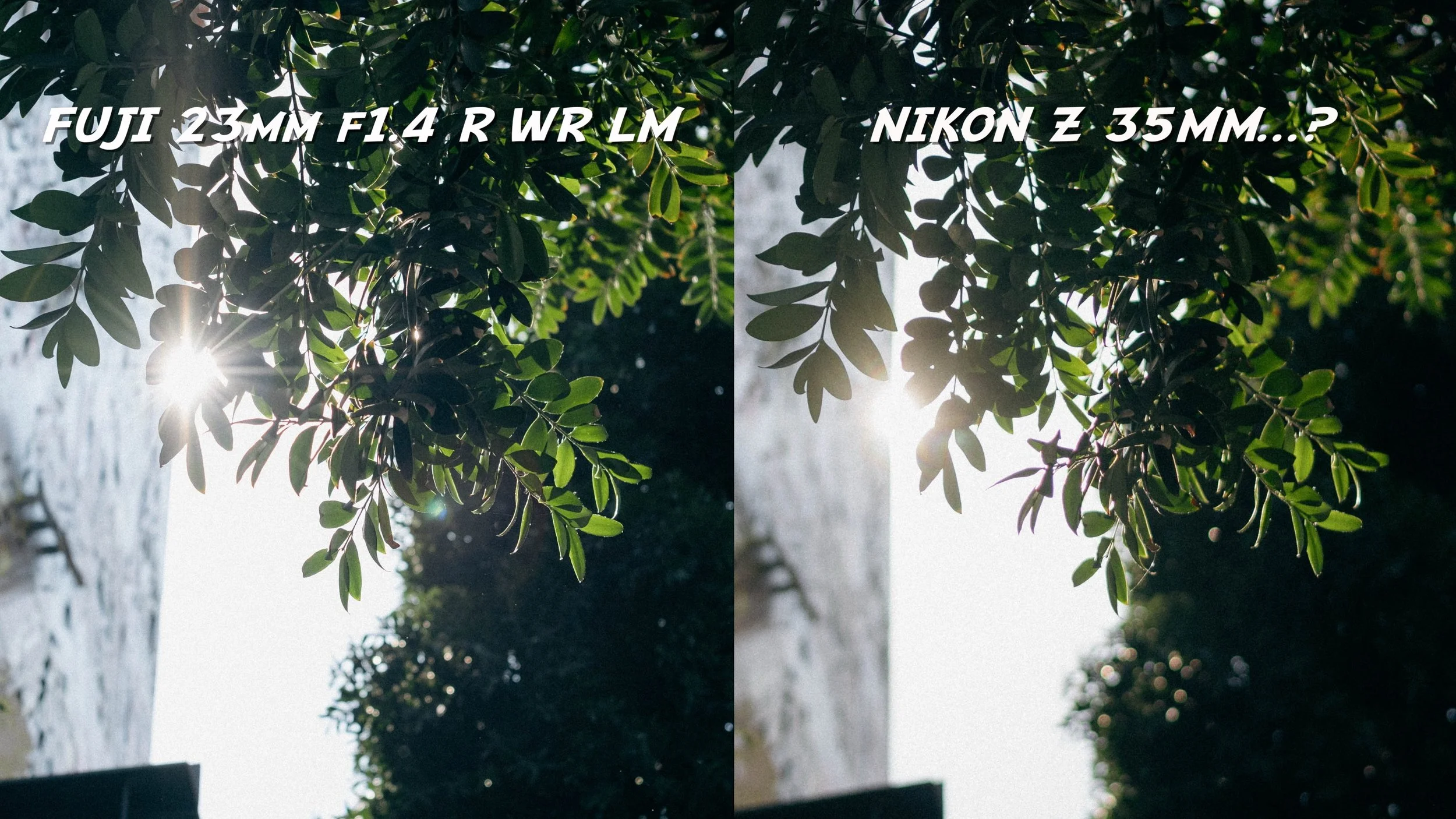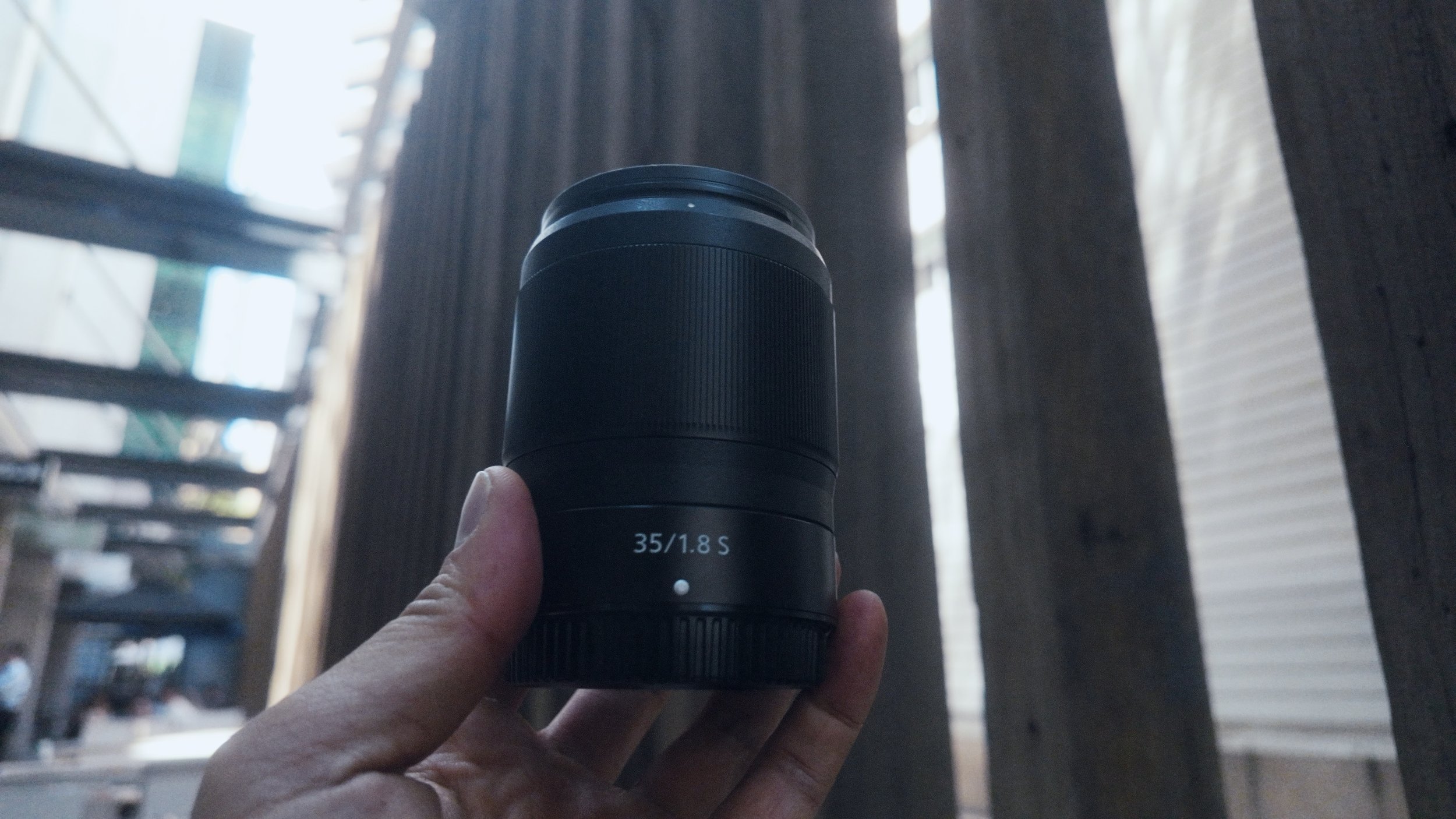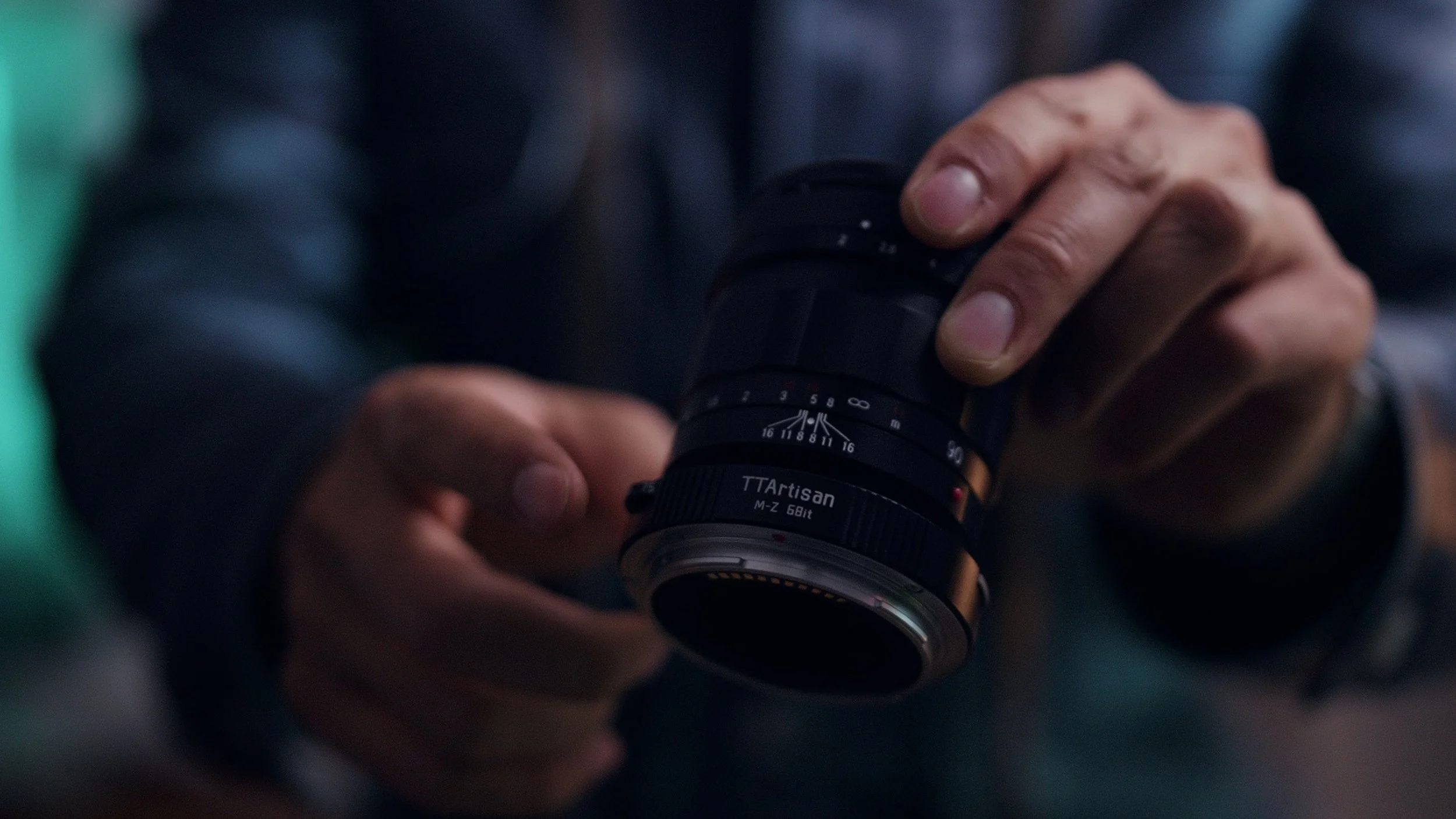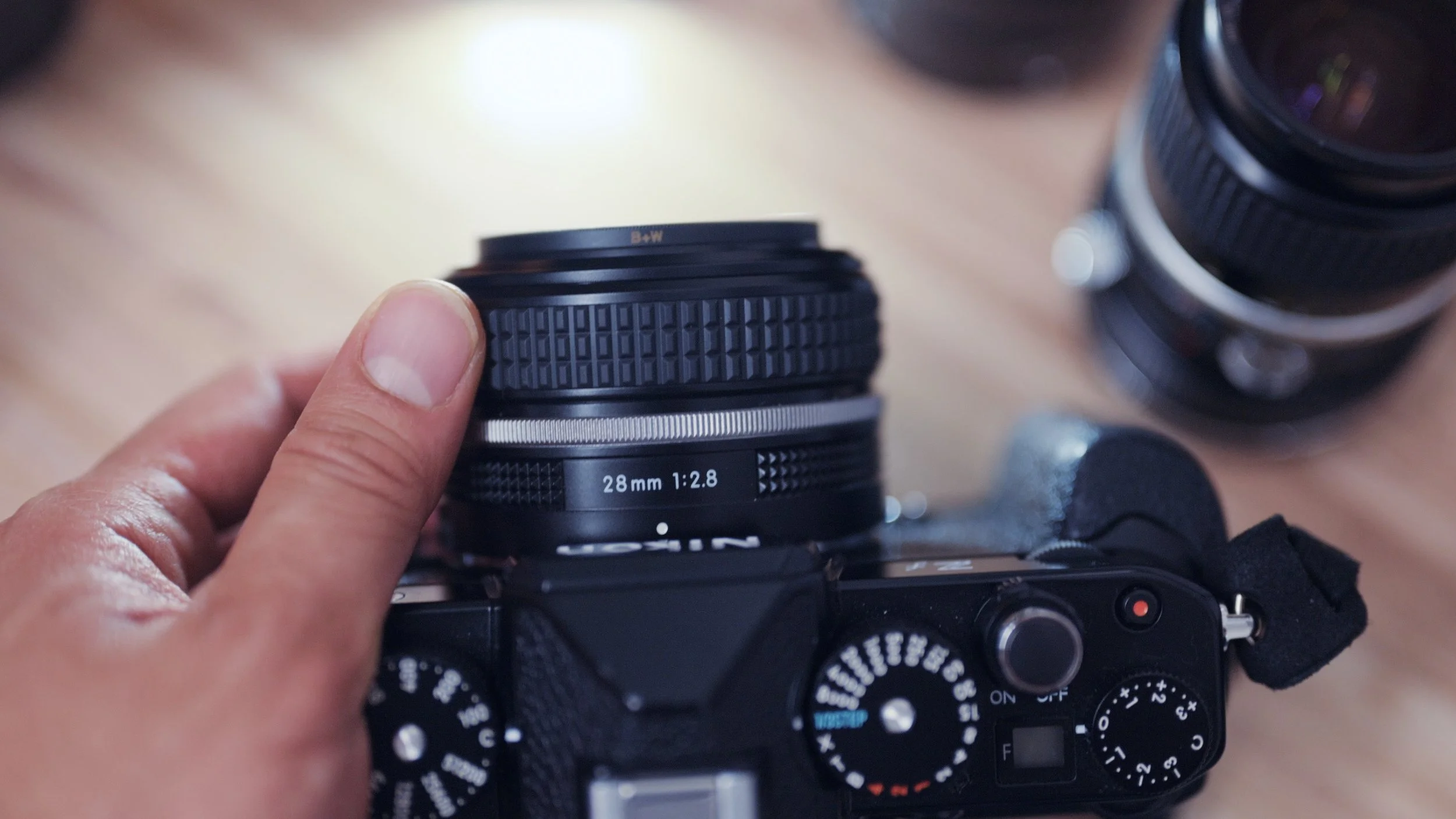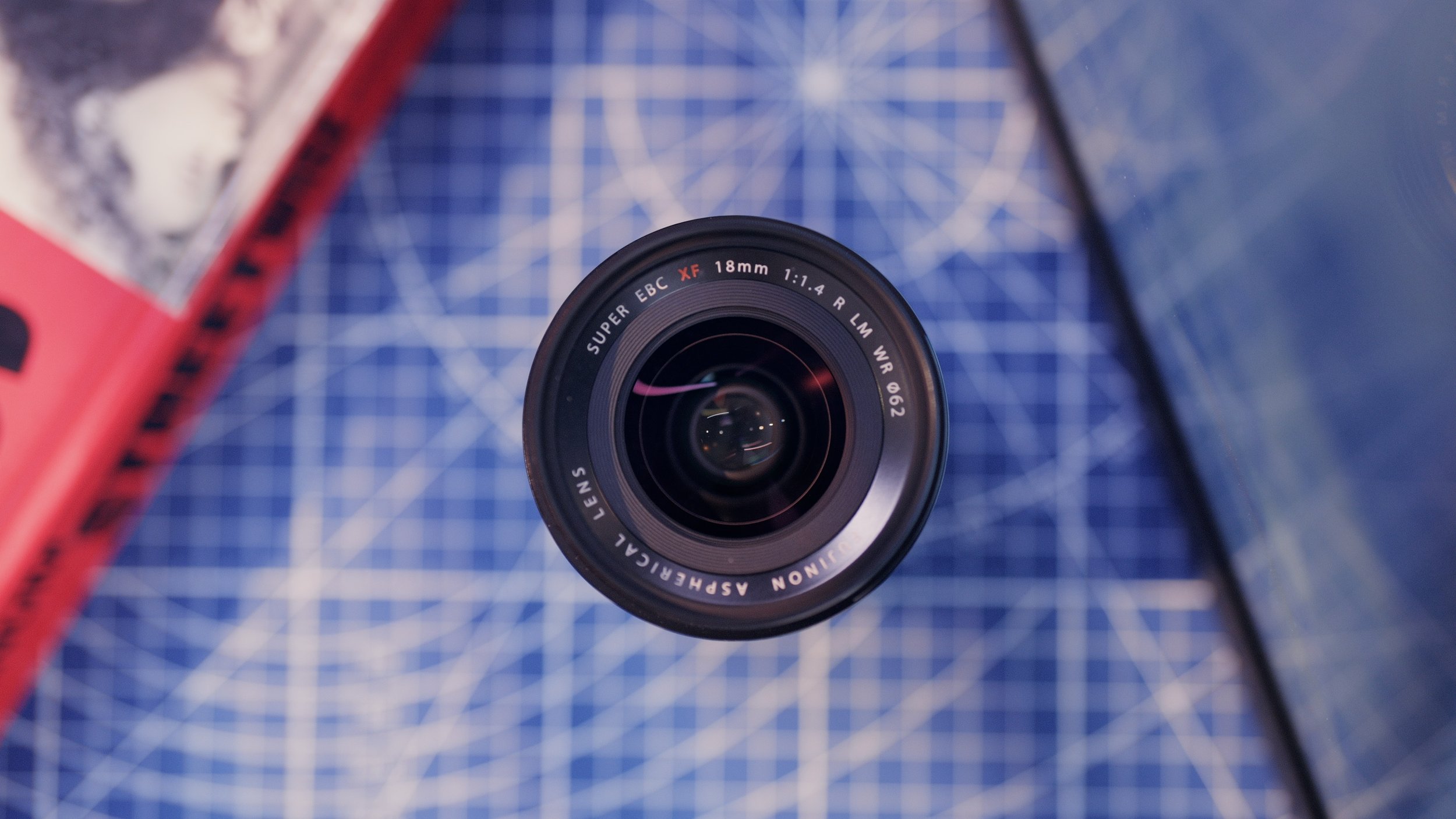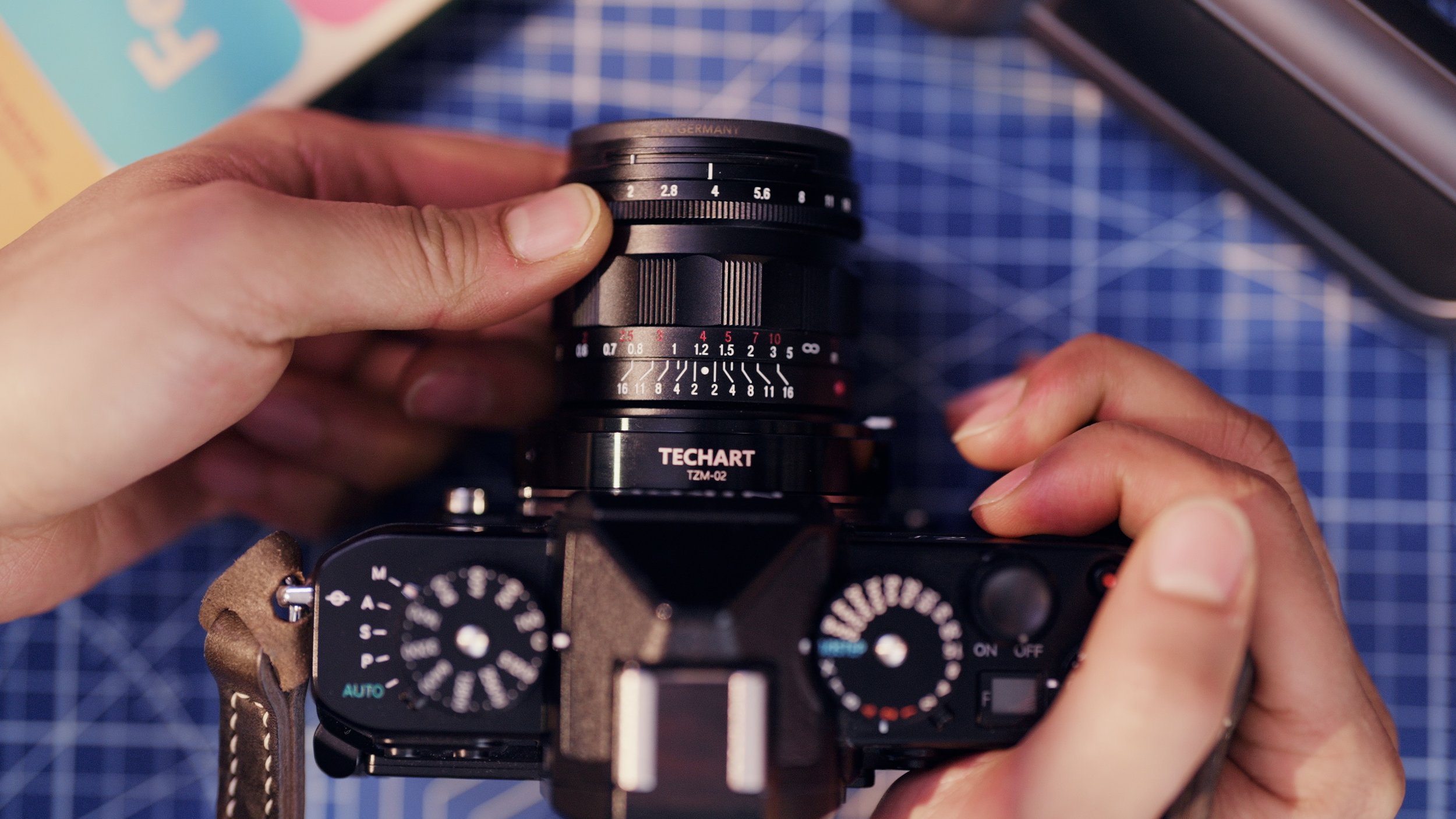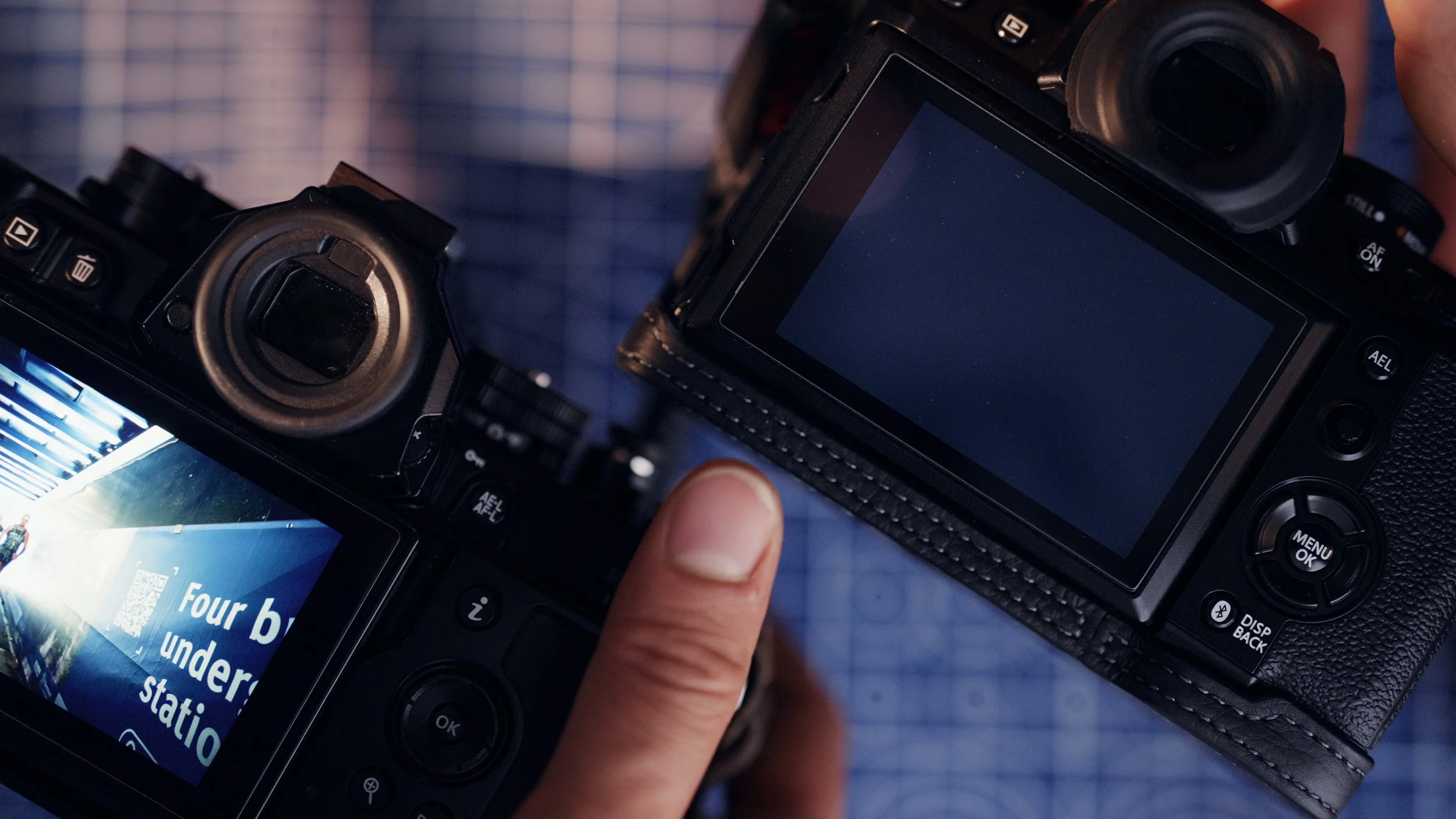I Obsessed Over Fujifilm vs Nikon Primes?
I tested my favourite Nikon lenses against Fuji’s latest primes to see what the brand I used to love is still behind?
Fuji updated their cameras, sensors, almost the entire X-mount lineup, and after comparing 10 lenses side by side on the Zf, XT5, I found 3 strange differences. I’m obsessing over these two systems so you don’t have to.
I need to know, once and for all, how good Fuji’s crop sensor second gen primes are.
About the same size as Nikon’s first gen full frame S-line, but up to double the price?
There are no sponsors for this blog post, I bought all the gear myself, except one mystery lens that fills a gap in Nikon’s Z lineup (it’s on loan from Mainline Photo).
A lens-by-lens showdown, Nikon vs Fuji, in the 5 most common focal lengths, starting with:
I. 35MM
A 35mm equivalent makes you work a bit harder than you’d like, but there’s a reason Fuji make so many.
Street photography is embedded into the brand’s DNA, and a 35 - or 23mm on Fuji is perfect for a modern urban scene like this.


Glass doors, reflections, alleyways, signs, the constant flow of commuters fills the frame on either side. As soon as any figure or shape is distorted it takes you out of the reality of that moment. On 35mm lens designers don’t have to work as hard to get rid of distortion in the corners.
The scene speaks for itself.


Just like the image quality from Fuji’s most premium 35mm equivalent - the XF 23mm f1.4 LM RWR. More than resolves the XT5’s 40 megapixel sensor, sharp, contrasty, but you can see the ZF’s 24 megapixel sensor with a mystery 35mm looks just as crisp.
If I don’t like a bigger lens though, couldn’t I go with a slower 35mm? The 35mm field of view is neutral - it can benefit from more visual tricks.


When layering the foreground sign, alongside the leading lines down into the alley, separation that comes with a fast 35 adds more flavour if you want it. There’s more foreground separation on the full frame Zf than the XT5, but did I use the Nikon 35mm 1.8 S, or the manual focus Voigtlander 35mm f2 APO?
Either way the Zf images in flat lighting look almost identical to the XT5 in detail, but this leads me to the first subtle difference:
Metering.
Both cameras were on multi or matrix metering, aperture priority, exposure compensation set to 0, shot in RAW, edited with the exact same lightroom settings - and you can see the Fuji images just seem brighter. Not across the board, the shadows seem to be lifted by half a stop or more. I’m not messing with any of the dynamic range settings,
I don’t know why it’s tuned this way by Fuji, maybe they’re trying to minimise noise by making sure the shadows aren’t underexposed. My personal high ISO threshold on Fujifilm is 12800, compared to 32000 on the Zf. With a fast 1.4 lens and IBIS there’s never a need to go so high though?
Low light ability alone isn’t reason enough to switch.
Fuji have done a great job with their new 23mm 1.4 - it’s much better corrected than my old mark 1 23mm 1.4, even though the amount of separation is still noticeably less than the 35 I’m using on the Zf. Nikon have a 35 1.4, and 1.2, both faster than this 35, whereas this is as fast as Fuji gets in this focal range.
I almost exclusively shoot street and travel - less isolation isn’t a problem for me, but if you take more portraits, you might prefer the full-frame look. Where you’ll see the biggest performance gap is in this next frame.
Backlit leaves, sunlight hitting the glass at different angles. There’s less purple fringing in the blown out highlights on Fuji than on Nikon, and by now you should have figured out which Nikon 35mm I’m using?
This amount of fringing isn’t terrible, but it is the most pronounced out of any Nikon S lens, which means it’s the Nikon 35mm 1.8S.
Not the Voigtlander 35mm f2 APO, that’s a better corrected lens at the cost of being manual focus only.
The Fuji’s CA control is very impressive, but Nikon’s 35 does perform better in flaring and ghosting. Those Nano crystal coatings on Nikon’s S lenses are no joke - they dampen flare in a beautifully subtle way that maintains contrast.
But apart from these minor aberrations the difference between Fuji and Nikon in this premium 35mm category?
Handling.
Aperture ring, all metal build on the Fuji versus mostly metal build and no aperture ring on the Nikon.
There’s really not much in it.
II. 40MM
40mm is the new “one and done” focal length for a lot of photographers, as you can see by all the lines and geometry in this train station walkway.


Like 35mm 40mm is still neutral, it’s not a “statement” lens filled with exaggerated visual signature, which is also the case for this abandoned scooter - all the lines in this tunnel converge towards it and not only is there no distortion, 40mm makes it feel more natural than 35?


Closer to the action right there in the moment, without having to stand too close, and due to the optical design of 40mm it can be a much more compact lens as well.
There’s two “first party” 40 mil lenses on Nikon, 2 for Fuji as well. Nikon’s 40mm f2, and the Voigtlander 40mm 1.2 - I’m using one of those. Both quite small and compact as far as full frame lenses go, and to further level the playing field I stopped the full frame 40mm down to f4. This theoretically matches the f2.8 maximum aperture on the APS-C Fuji 27mm.
Sharpness on the Fuji 27mm is impressive - about as good as this full-frame 40mil stopped down in the centre - it is on Fuji’s list of lenses that can fully resolve the 40 megapixel sensor.


Aberrations? This full-frame 40mm looks better - not a fair fight given it’s stopped down versus wide open on the Fuji. Flare resistance is good on both. Voigtlander may have paid the Z-mount licensing fee, but this necessarily doesn’t include Nikon’s arneo lens coatings. But these coatings aren’t supposed to be on Nikon’s 40mm lens either, so which 40 is it?


The Voigtlander 40mm 1.2 is famous for its jagged edge bokeh when stopped down - its aperture blades are flat, whereas Nikon’s 40mm uses rounded blades. So based on the rounder lookin bokeh balls - I’m using Nikon’s 40mm f2, which approaches peak sharpness at f4, and as sharp as the Fuji 27mm in the centre, corners are not fantastic on either lens.
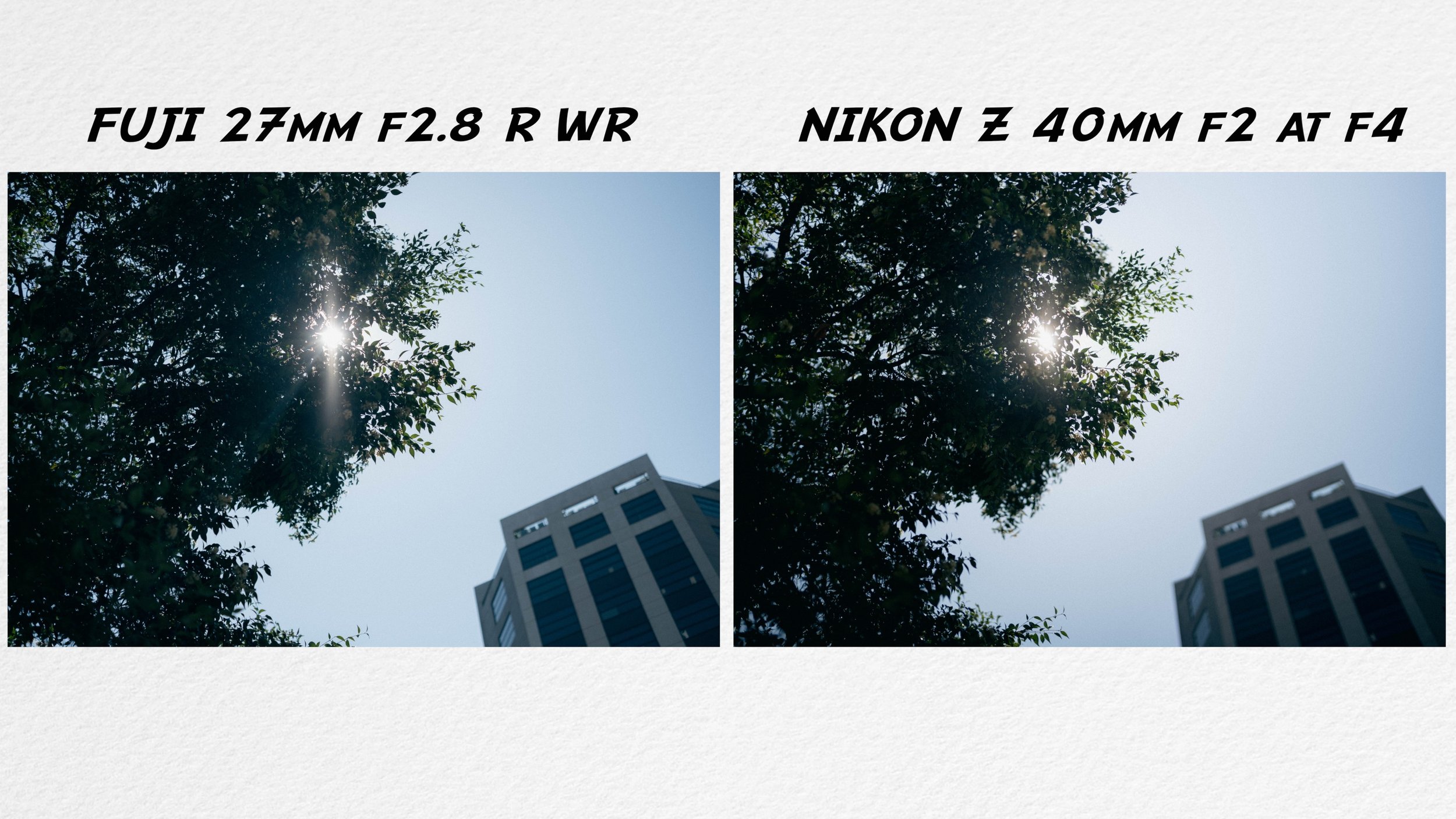

All the sample images in this blog post were edited from RAW files using my free Chrome emulation preset. They work with most RAW files from different cameras as long as you use “Adobe Color” as the starting base.
Download it for free here.
How about the build? Fuji’s 27mm has an aperture ring, weather resistant, metal mount, Nikon’s 40mm is plastic fantastic, including at the mount, although it is weather resistant too.
The second subtle difference between the Zf and XT5 is not the ergonomics - Fuji has had more time to take customer feedback, refine the grip, but that’s why the next subtle difference surprised me:
Haptics.
The XT5’s lockable dials when unlocked? Easy to bump, less clicky and the positions feel less precise than on the Zf.
The exposure comp dial? Super easy to bump, even though neither camera is lockable it’s a more tucked away on the Zf.
The switches that sit under the dials are easy to bump on both cameras, though it feels a little easier on the XT5.
It’s that “Still to Movie” switch that’s caused a lot of issues for Fuji.
By making their flagship the XH line Fuji diverted resources away to make the price of the lower tier XT5 make sense.
For me, 2 months in? My copy is fine, but it doesn’t inspire as much confidence as the Zf. Other than the slightly annoying flip screen, the Zf feels like an all-in, photo-first, product. It’s so satisfying and fun to use.
But then comes the ZR - Nikon’s turn to attempt that photo to video switch.
Can we trust they’ll get it right?
III. 85MM
I love telephoto lenses to changes the look of everyday scenes we walk past without thinking into something more mysterious.


Still wide enough to add some foreground elements for layering, but the idea of peeking into a train carriage speeding away is counter-intuitive - an 85 or 90 - gives you that voyeuristic ability.
I get it’s not everyone’s cup of tea, which also describes Fuji’s 56mm f1.2. This is the mark 2 I’m testing - its autofocus quirks are enough to scare many away from its super sharp image quality.


Nikon’s 85mm 1.8S is much less controversial, a longer, tighter version of their amazing 50 1.8S (we’ll talk about that next). Super sharp, well controlled for aberrations, matches the other 1.8S primes.
If you want even sharper you can go for Voigtlanders’ 90mm f2 APO. It only comes in M mount so far, but I adapt it using the TTArtisan 6 bit adapter. It has a focal length selector on the side to get the EXIF data and IBIS right.
Can you guess which telephoto I’m using on the Zf?
The amount of detail in both these scenes is great - both lenses are super sharp, but what most people look for in a telephoto is what’s not in focus. Neither of these lenses have flat field curvature. The bokeh on both catseye towards the corners, not much onion ringing but there is an edge on the bokeh balls.


Backlit flare follows the same trend - a nice gentle glow on these lamps on the Fuji 56mm, you don’t lose contrast but there is less detail amidst the glow, whereas the Nikon telephoto I’m using - either the 85mm 1.8S or the Voigtlander 90mm f2 APO - dampens the flare significantly.


And this is how you know this is the Nikon 85mm f1.8S, the one area it performs better than the Voigtlander 90mm f2 APO optically. Nikon’s lens coatings really are the best in the industry out of any lens I’ve tested.
Both of these telephoto lenses are great - 56mil 1.2 on APS-C matches the depth of field of 85 1.8 on full frame and if you’re in the Fuji system and know how to work with its autofocus? This Fuji 56mm is worth your time.
But in terms of performance this Nikon has never let me down.
IV. 50MM


50mm is still plenty wide for everything other than tight group shots, and you can crop a 50mm image and pull off a tighter look. Due to a 50’s proportions and falloff it can act like a loger focal length in a pinch, something you can’t get away with on a 28mm or 35mm. If it wasn’t so versatile why would Fujifilm make so many 50mm equivalents?
The one I’m testing is the most premium the Fuji 33mm f1.4, how does it stack up against Nikon’s options? The 50mm f1.8 S is optically the best in the S-lineup, perhaps only bested by Voigtlander’s 50mm f2 APO.
Which Nikon 50mm is it?


I love using 50mm more than wider focal lengths for reflections - by the time the light bounces from the glass into the lens there’s a loss of intimacy, a 50 closes the distance better. I’m standing right next to the pane of glass but there’s still enough room to layer - the umbrella, silhouettes, shadows - it’s why I love 50.


Along with its width, how much you can fit into the frame with a 50, you can also use it to isolate a subject - like these flowers overhead. The Fuji 33mm f1.4 looks fantastic - the isolation and separation looks very comparable to the 50 on the Zf - even though both the 50 1.8 S and the 50 f2 APO are slower, they both have close to flat field curvature where the bokeh looks more even across the frame.
What about CA and aberrations? both of these 50 equivalents look fantastic - minimal, well controlled, and when it comes to flare resistance? For what it’s worth both the Nikon 50mm 1.8S and the Voigtlander 50mm f2 APO perform great here - you can’t tell which 50mm it is just based on flare.


All the sample images in this blog post were edited from RAW files using my free Chrome emulation preset. They work with most RAW files from different cameras as long as you use “Adobe Color” as the starting base.
Download it for free here.
The Fuji 33mm f1.4? Even though there’s a bit more ghosting. It’s a very impressive lens with beautiful falloff, clearly next generation compared to the old XF 35mm 1.4, BUT the size isn’t that much smaller than Nikon’s 1.8S lineup while being double the price.


Before revealing which 50mm I’m using on the Zf, are the Voigtlander APOs worth it? The Nikon 1.8S lineup is so close to apochromatic, their optical performance already close to perfect, and there’s autofocus. It’s a little harder to justify the manual focus APO label at the 50 mm focal length. It makes sense for 35 mm, if you want a cleaner look than the 35mm f1.8S the Voigtlander 35mm f2 APO is But it make even more sense for:
V. 28MM
Of course there’s the Nikon 28mm f2.8 Z - beautifully compact, modern performance, OR I could be using Voigtlander’s 28mm f2 APO in M-mount. But Fuji has a first-party option - their 18mm f1.4 - which I think is the best Fuji lens I’ve tested.
A 28mm field of view is it’s all about layering - blue swirls, blue lights, commuters, all line up and fit into this frame. There’s not much depth of field difference - does that tip you off as to which 28 I’m using on the Zf?


But separation is not the main thing I’m concerned with when it comes to 28mm - neither have the best bokeh although you can get some in a pinch.


It’s not sharpness either - although it helps when fitting more visual elements in at minimum focus distance I could get closer on the Fuji 18mil than the 28mm I’m using on the Zf, both do look crisp.


My main concern with 28mm isn’t aberrations - CA, fringing either - I actually think a fast wide vintage look is beautiful at 28mm. Rather than render modern scenes a little too accurately, aberrations give the wider field of view more texture - less smartphone looking. But both of these 28mm equivalents are well controlled - flare dampened to a similar extent depending on the angle of light, CA and fringing is minimal.


My actual main concern with 28mm? Distortion - how warped the lines look near the edges. In this next frame of the alleyway - the “This way” sign looks sharp on both the XT5 and the Zf - the edges look straight, the details of the alleyway look crisp on both.


So which 28mm did I use on the Zf? The telltale sign is this Santa frame.


The Nikon 28mm 2.8 can get almost as close at minimum focusing distance as the Fuji 18mm 1.4, whereas the Voigtlander 28mm APO is still a Leica M lens, not native Z-mount for now - its minimum focus distance is limited to 0.5 metres.
Courtesy of Mainline Photo - Australia’s best stockiest of Voigtlander glass.
I’m using the Voigtlander 28mm f2 APO - a fantastic option adaptable to any mount in M mount, and a Z mount version was just announced.
This means the 50mm I was using was the Nikkor 50mm 1.8 S, if you’re still reading at this point.
Looking back across all these lenses - I think Fuji have done an incredible job.
Their newer line of premium primes every bit as good as Nikon’s full-frame options with two caveats. One Nikon’s S primes are more resistant to flare across the board, and two is the price.
Prime for prime a Fuji kit is significantly more expensive than Nikon, and it isn’t that much smaller and lighter either?
The price, better low light and build quality on the Zf, may offset the extra weight compared to Fuji, as does the last subtle difference - number 3:
Speed.
The ZF uses a non-stacked slow readout sensor, but I remain impressed by the Expeed 7 processor. Quick to start up, quick to check images, navigating menus is smooth. The XT5? Sluggish startup time. Checking the images - strangely slow, not just compared to the Zf, but also the much older XT3. This bigger 40 megapixel sensor just doesn’t seem a good match for the XT5’s processor, which may be the root cause of those persistent autofocus issues. A camera’s a little slower in handling than you’d like, each interaction a little less robust - this is where you might start to lose trust - not in the camera but more so the brand? More megapixels might be easier to sell, but I would’ve preferred speed or low light on the XT5?
But the slightly more compact Fuji primes are amazing if you can stomach the price - enough reason to overlook the XT5’s shortcomings. For my channel it makes sense to have both to cover new lenses for both mounts, but if I could pick only one? The ZF isn’t perfect, but it got so many little details right as a photo-first device, I can’t help but want to keep using it?
Through all the chaos this year.
All the changes yet to come.
The Zf will be my photo companion through it all.
Happy shooting everyone, talk soon.
Jack.
This blog post is sponsor-free. If you’d like to support my work please consider purchasing gear through my affiliate links:
Nikon Zf: https://geni.us/fRFp
Nikon 35mm f1.8 S: https://geni.us/HYuWa
Nikon 40mm f2: https://geni.us/0AAhXJ
Nikon 50mm f1.8 S: https://geni.us/sQ55h
Nikon 85mm f1.8 S: https://geni.us/ItonAtp
Nikon 28mm f2.8: https://geni.us/tyZX2A
Fujifilm X-T5: https://geni.us/s5dHe
Fujifilm 23mm f1.4 LM R WR: https://geni.us/pKg7
Fujifilm 27mm f2.8 R WR: https://geni.us/rbXC2D
Fujifilm 33mm f1.4 LM R WR: https://geni.us/xDUQ5p
Fujifilm 56mm f1.2 R WR: https://geni.us/URPhn1X
Fujifilm 18mm f1.4 LM R WR: https://geni.us/WPLEZww

